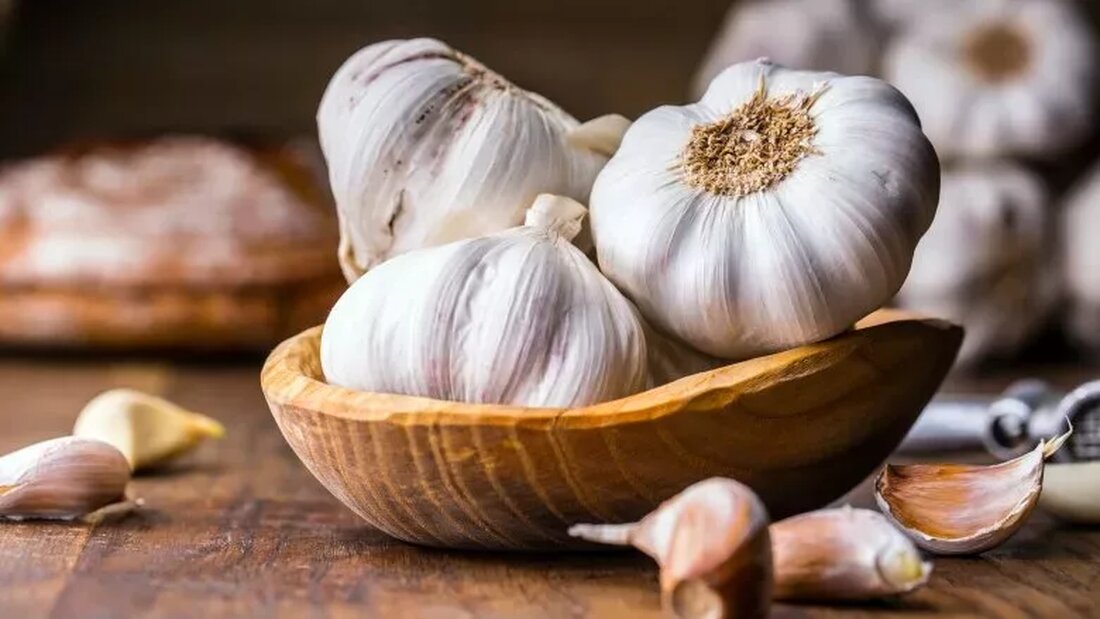Garlic helps against high blood pressure, cancer and protects the liver
Garlic (Allium sativum) is a plant used in cooking and medicine and is best known for its distinctive taste and aroma. Although garlic is often used as a spice, it is technically a vegetable. A member of the Allium family, it is a close relative of onions, shallots, leeks and chives. The benefits of garlic don't end with adding flavor to foods. It is a legitimate superfood that has been used for an amazing variety of medicinal applications for thousands of years. History of Garlic For over 7,000 years, humans have consumed garlic both in cuisine and...

Garlic helps against high blood pressure, cancer and protects the liver
Garlic (Allium sativum) is a plant used in cooking and medicine and is best known for its distinctive taste and aroma. Although garlic is often used as a spice, it is technically a vegetable. A member of the Allium family, it is a close relative of onions, shallots, leeks and chives. The benefits of garlic don't end with adding flavor to foods. It is a legitimate superfood that has been used for an amazing variety of medicinal applications for thousands of years.
History of garlic
People have been consuming garlic for both cooking and medicine for over 7,000 years. The plant is native to Central Asia, but its use and cultivation have spread throughout the world. The ancient Egyptians gave garlic to the workers building the pyramids to increase stamina and prevent disease. In ancient Greece, Olympic athletes chewed garlic before competing in the games. References to garlic can be found in Homers Odyssey, 5,000 year old Indian medical texts and the Bible. Garlic was used as food and medicine in the ancient Roman, Chinese, Viking, Phoenician, Israelite and Persian cultures.
Now garlic remains a popular food and flavoring. It is a staple of Mediterranean, Indian, Middle Eastern, Chinese and Southeast Asian cuisines. Garlic's potential medicinal uses are even drawing renewed interest from researchers.
Garlic Nutritional Profile
At first glance, garlic's nutritional properties may seem puzzling. If you look at the official garlic nutrition facts, a typical serving of garlic (3-9 grams) does not provide a significant amount of the essential nutrients typically listed. It does not contain a significant amount of fiber, protein, iron, potassium or vitamins A, D, E or most B vitamins.
It is a good source of selenium and contains small amounts of calcium, magnesium, phosphorus, and vitamins C and B6, but there are better sources of these nutrients. You'd have to eat a lot of raw garlic to get a significant amount of these nutrients, and while it's delicious, I think very few of us are up to the challenge.
What exactly makes garlic such a valuable health-promoting tool in so many different cultures? Garlic owes its healing properties to the presence of several sulfur-containing phytochemical compounds. Fresh garlic contains a sulfoxide compound called Alliin. When fresh garlic is chopped, crushed or damaged, alliin is produced by an enzyme called Alliinaseconverted into allicin. Allicin is responsible for much of the pungent smell of garlic. Its real purpose is to act as a defense mechanism and protect the plant from pests.
Allicin is unstable and further breaks down into other sulfur-containing compounds, including diallyl disulfide, diallyl trisulfide, and diallyl tetrasulfide. In the human body, diallyl disulfide breaks down into allyl methyl sulfide, the main cause of garlic breath. (Side note: To reduce garlic breath naturally, try sucking a lemon wedge, drinking green tea, or eating spinach or apple. These foods all contain substances that mask or break down the smell of garlic.)
It is these sulfur-containing compounds that give garlic its healing abilities. Allicin's pest-resistant properties still work when the compound is in the human body. This makes garlic a surprisingly good defense against harmful organisms such as bacteria, viruses, protozoa and fungi.
Diallyl disulfide also possesses antimicrobial properties, as well as anti-cancer and heart-healthy properties. The exact mechanisms behind garlic's health benefits are not yet fully understood, but research is ongoing. We know garlic can be a powerful tool to support a healthy lifestyle. Here are some ways garlic can help.
Health Benefits of Garlic
1. Garlic supports cardiovascular health
Garlic is one of the best foods for heart health. Studies have shown that garlic lowers cholesterol and lowers lipid levels in the blood. Experimental and clinical studies on the cardiovascular benefits of garlic have shown that it has a positive effect on atherosclerosis, hyperlipidemia, hypertension and thrombosis. Garlic also appears to have the ability to prevent blood clots. Tests are currently underway to investigate the mechanism of this effect. (Source)
2. Garlic can help with high blood pressure
Researchers have found that oral administration of garlic can lower blood pressure in both human and animal studies. Surprisingly, there was a measurable reaction after just a single dose. Chronic oral administration of garlic has long-term positive effects. Allicin appears to have a relaxing effect on the smooth muscle cells of the pulmonary artery, allowing the artery to open more fully. This does not mean that you can switch to an all-bacon diet and expect to eliminate the consequences. When combined with a balanced diet, garlic can significantly improve blood pressure. ((link removed))
3. Garlic is nutritional support against cancer
Studies around the world have found a link between high garlic intake and a reduced risk of cancer. Increased garlic consumption is associated with a reduction in cancers of the stomach, colon, esophagus, pancreas, prostate and breast. The United States National Cancer Institute has stated that garlic may be the most effective food for cancer prevention. ((Link removed), (Link removed))
4. Garlic and diabetes
Garlic can also provide significant benefits for diabetics. Experimental studies have shown that garlic lowers blood sugar levels, and this hypoglycemic effect has been replicated in animal studies. Treatment in humans is less studied but looks promising. Garlic has been reported to lower blood cholesterol levels and reduce insulin resistance. However, more studies are needed to fully understand the effects of garlic on human blood sugar levels. ((link removed))
5. Garlic provides liver protection
Garlic is one of the best foods to cleanse your liver. It may help mitigate the effects of fatty liver disease and provides hepatoprotective effects of certain toxic substances. Studies have shown that garlic can protect liver cells from paracetamol, gentamycin and nitrates. ((Link removed), (Link removed))
6. Antimicrobial properties of garlic
For centuries, traditional medicine has used garlic for its antimicrobial properties. Modern studies have shown that garlic's antibacterial properties are effective against Salmonella, staphylococcal infections, Clostridium (the cause of botulism), Proteus, Mycobacterium and H. pylori. Garlic has even been suggested as a treatment for drug-resistant tuberculosis. ((link removed))
The effect of garlic against harmful organisms does not stop with bacteria. It is antiprotozoal, antifungal and even antiviral. In vitro studies have shown garlic to be effective against influenza, cytomegalovirus, rhinovirus (the cause of the common cold), viral pneumonia, rotavirus, herpes simplex 1 and 2, and even HIV. Unfortunately, these results are only confirmed in test tube studies. How the active ingredients in garlic react to viruses in the human system remains to be seen. ((link removed))
Studies of cold sufferers have found that those who consumed garlic extract had milder symptoms and a shorter duration of illness than placebo groups, but the exact mechanism behind this phenomenon is still unclear. Further research is needed to better understand the healing properties of garlic. ((link removed))
7. Garlic is a powerful antioxidant
Free radicals are unstable molecules that damage DNA and lead to poor health. Garlic contains powerful antioxidants that fight these free radicals. When allicin breaks down, an acid is created that reacts with the free radicals and traps them. Researchers at Queens University in Ontario believe this is the most powerful antioxidant ever discovered. ((link removed))
Ways to Consume Garlic
There are hundreds, if not thousands, of recipes that contain garlic. The best way to absorb the health benefits of garlic is to consume it raw. Raw garlic can be a little intense for some, but there are several ways to temper the piquancy while still retaining the full health benefits. My favorite is to add raw garlic to a dressing like the lemon garlic dressing used in this cabbage wedge recipe or the balsamic vinaigrette of this green bean salad.
Although it may sound a little strange to those who haven't tried it, you can actually drink garlic. To quickly strengthen the immune system, I like to prepare garlic tea:
Classic garlic tea recipe
Ingredients
- 1 Bio-Knoblauchzehe
- ½ Limette oder Zitrone, entsaftet
- 1 TL roher Bio-Honig (ptimal)
preparation
- 1 Bio-Knoblauchzehe sehr dünn schneiden.
- Eine Tasse Wasser kochen.
- In Scheiben geschnittenen Knoblauch in eine Tasse geben.
- Gießen Sie das heiße Wasser über den Knoblauch und decken Sie die Tasse mit einem kleinen Teller ab.
- 10 Minuten ruhen lassen.
- Fügen Sie den Saft einer halben Limette hinzu.
- Fügen Sie einen halben Löffel rohen Bio-Honig hinzu. (optimal)
If you don't like tea, there is another emergency immune booster. Finely chop two cloves of garlic, mix with the juice of ten limes and drink. If it's too strong, add some fresh orange juice to mellow the taste.
More research may be needed, but it is already clear that garlic is an incredible natural remedy with amazing health benefits. Our ancestors knew this and we are now rediscovering the full power of this spicy vegetable.

 Suche
Suche
 Mein Konto
Mein Konto
